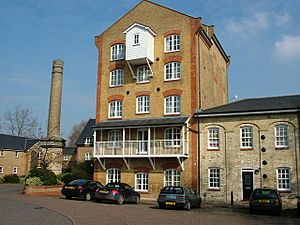John Tate (papermaker) facts for kids
John Tate was a very important person in English history. He was the first person to make paper in England! He lived in the late 1400s. John was born around 1448. He was a businessman from London and belonged to a group called the Mercers Company.
Who Was John Tate?
The Tate family was very good at business. They traded with people all over the world. John Tate was known as "John Tate the younger" by people who lived at the same time. His father, also named John Tate, was the Lord Mayor of London in 1473. It's easy to get them mixed up! There was even another John Tate, a cousin, who was also Lord Mayor later on.
Making Paper in England
John Tate bought an old watermill called Sele Mill. This mill was just outside a town called Hertford. Today, Hertford has grown bigger and includes the area where the mill is. Sele Mill is on the River Beane, which is a special type of river called a chalk stream. It's also close to where the River Beane joins the River Lea.
Tate changed this old mill into a paper mill. He started making paper there in the 1490s. He might have even started earlier!
The area around the River Beane was mostly countryside. But John Tate found customers nearby. Some of his paper was used by the Woodhall estate for keeping records. This was great for his business! The mill was also less than 30 miles from London. This meant he could easily send his paper to the big city. He could use Ermine Street (an old road) or the River Lea to get there.
One important customer in London was Wynkyn de Worde. He took over the printing business of William Caxton in the 1490s. Another very important customer was Henry VII of England, the king! The king had given Hertford Castle to his wife in 1487. He visited Tate's paper mill in 1498 and came back again the next year. People think that one of the special designs Tate put on his paper, called a watermark, was a Tudor rose. This design was probably made especially for the king.
The paper John Tate made was very good quality. However, the mill stopped making paper around the early 1500s. We don't know exactly why. In his will (a document about what happens to his things after he dies) from 1507, Tate mentioned the mill. He also mentioned that he still had a supply of white paper there. Maybe he couldn't sell his paper for a good enough price. As far as we know, there were no other paper makers in Britain at that time.
John Tate's Last Years
John Tate wrote his will in 1507. He died that same year or the year after. He was living in a part of London called Mincing Lane. He was buried at a church called St Dunstan-in-the-East.
His Legacy
Sele Mill was rebuilt much later, at the end of the 1800s. Today, it has been turned into apartments where people live.
After John Tate's time, the paper industry started up again in Hertfordshire. The valley of the River Gade became a good place for paper mills. A big step forward happened in 1803. A machine that could make paper continuously was installed at Frogmore Mill.


